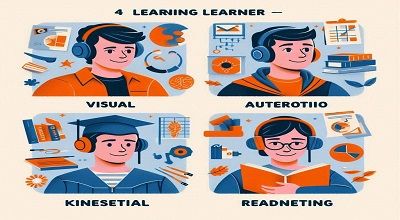4 Learning Modalities
The term “4 learning modalities” refers to the different ways individuals prefer to learn and process information. There are various models, but one common framework categorizes learning modalities into four types:
- Visual Learning (Spatial): Visual learners prefer to see and use images, diagrams, charts, and other visual aids to understand information. They often benefit from watching videos, looking at pictures, and using color-coded notes.
- Auditory Learning: Auditory learners learn best through listening. They often benefit from lectures, discussions, and other forms of spoken information. These individuals may prefer verbal explanations and may find it helpful to discuss ideas aloud.
- Reading/Writing Learning (Linguistic): Learners with a preference for reading/writing enjoy written words. They may prefer to read books, take notes, and engage in written exercises to enhance their understanding. This modality is often associated with a strong preference for reading and writing as primary learning tools.
- Kinesthetic Learning (Tactile): Kinesthetic learners learn best through hands-on experiences and physical activities. They benefit from actively manipulating objects, engaging in experiments, and participating in activities that involve movement. These individuals often have a need for physical involvement to understand and remember information.
Examples of 4 Learning Modalities
Here are examples for each of the four learning modalities:
Visual Learning (Spatial)
- Watching educational videos or documentaries.
- Using mind maps, charts, and diagrams to organize information.
- Creating and using flashcards with visual elements.
Auditory Learning
- Listening to lectures or podcasts.
- Participating in group discussions or study groups.
- Explaining concepts aloud to oneself or others.
Reading/Writing Learning (Linguistic)
- Reading textbooks, articles, or written instructions.
- Taking detailed written notes during lectures.
- Engaging in written exercises, essays, or journaling.
Kinesthetic Learning (Tactile):
- Conducting experiments or hands-on activities.
- Using manipulatives or physical objects to understand concepts.
- Role-playing or simulations that involve physical movement.
Summary
It’s important to note that many people don’t exclusively fall into one category; instead, they may have a combination of preferences or a dominant modality with secondary preferences. Effective teaching and learning often involve incorporating a variety of modalities to cater to different learning styles. Remember that individuals often have a combination of preferences, and it can be beneficial to incorporate a mix of these modalities in teaching and learning environments to cater to diverse learning styles.
